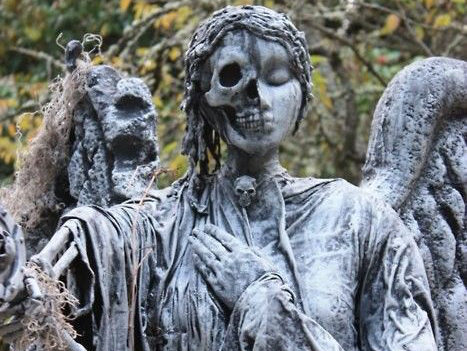The Nordic afterlife has several realms. Besides the most commonly known Valhalla, ruled by Odin; the nordic afterlife also has Folkvang,“the field of the people” or “the field of warriors”, which is ruled by Freya; the underwater abode of the giantess Ran, to which warriors who died at sea went; and of course, Helheim.

The Old Norse sources are far from clear on exactly which afterlife one would go. Where one goes after death isn’t any kind of reward for moral behavior or pious belief, nor it is a punishment for immoral behavior.
Contrary to what may be commonly believed, the realm of Hel or Helheim, Old Norse for “Hidden,” is not a place of punishment in the Norse Religion, but simply a continuation of life somewhere else. The dead in Hel spend their time doing the same things that they did in life: eating, drinking, fighting, sleeping, and so forth. In some sagas, it’s even portrayed as a land of startlingly abundant life on the other side of death.

Of all of the Old Norse sources, only one describes Hel as a thoroughly unpleasant place: the Prose Edda of the thirteenth-century Icelandic scholar Snorri Sturluson. Snorri wrote many generations after Norse religion had given way to Christianity and ceased to be a living tradition, and he had a habit of stretching the evidence available to him to present his pre-Christian ancestors as having anticipated aspects of Christianity. His downright comically over-the-top portrayal of Hel is an excellent example of this tendency of his. For Snorri, the plate of the Goddess Hel is called Hunger (Hungr), her servants Slow (Ganglati) and Lazy (Ganglöt), the threshold of her door Stumbling Block (Fallandaforað), her bed Illness (Kör), and her curtains Bleak Misfortune (Blíkjandabölr). Few scholars accept such descriptions as being authentic products of the Viking Age.
Similarly laughable is Snorri’s assertion that all those who die in battle go to Valhalla, the sublime hall of the God Odin, while all those who die of sickness or old age go to Hel. Snorri himself blatantly contradicts his distinction between Valhalla and Hel in his version of the tale of the death of Baldr, Odin’s son, who is killed violently and is nevertheless borne to Hel. No other source makes this distinction, and several offer further examples to the contrary.
Helheim is governed by the Goddess Hel, daughter of Loki and the Jötunn Angrboda. Half of her body is of a beautiful woman, while the other half is of a corpse, sometimes depicted as white and bloodless, sometimes depicted as black as peat or even blue. Hel’s siblings are the Great Serpent Jörmungandr, Odin’s horse Sleipnir and the mighty wolf Fenrir.

The borders of Helheim begin by the river Élivágar (Ice waves). Crossing the river, the bridge Gjallarbrú (Gjöll Bridge), described as a covered bridge "thatched with glittering gold” leads to the great gates of Hel, named Nágrindr, (Corpse-gates), at the mouth of the Gnipahellir cave, where the wolf Garmr which means Hellhound, is howling every time the realm receive new arrivals. Only the dead can cross the gates of Hel, the living who visited the place had to resort to subterfuge, or even jumping the high walls surrounding the gate, as did Hermodr, while mounting Sleipnir.

The roots of Yggdrasil are firmly planted on Helheim, which may mean that the whole nine realms are anchored on the realm of the dead. The world-tree roots are constantly chewed upon by the dragon Níðhöggr (Malice Striker), who hopes to damage and topple Yggdrasil, thus ending the whole nine realms.
Sources:
Lindow, John. 2002. Norse Mythology: A Guide to the Gods, Heroes, Rituals, and Beliefs. Oxford University Press. ISBN 0-19-515382-0
Orchard, Andy. 1997. Dictionary of Norse Myth and Legend. Cassell. ISBN 0-304-34520-2
Simek, Rudolf. 2007 [1993]. Translated by Angela Hall. Dictionary of Northern Mythology. D.S. Brewer. ISBN 0-85991-513-1
Jesse Byock (2005) Snorri Sturluson, The Prose Edda. 1st. edition. London, England: Penguin Books Ltd. ISBN-13 978-0-140-44755-2













Comments (2)
Interesting that unlike the Christian premise of, ‘Do as I say or you will be punished,’ the Norse philosophy allows people to be themselves, and allows them an afterlife that seems to be a continuation of before-life. Thus the control the Christian religious sect had over the worshippers, that of fear, did not seem to exist, certainly not in the same way, with the Norse people. Fascinating.
Very interesting read